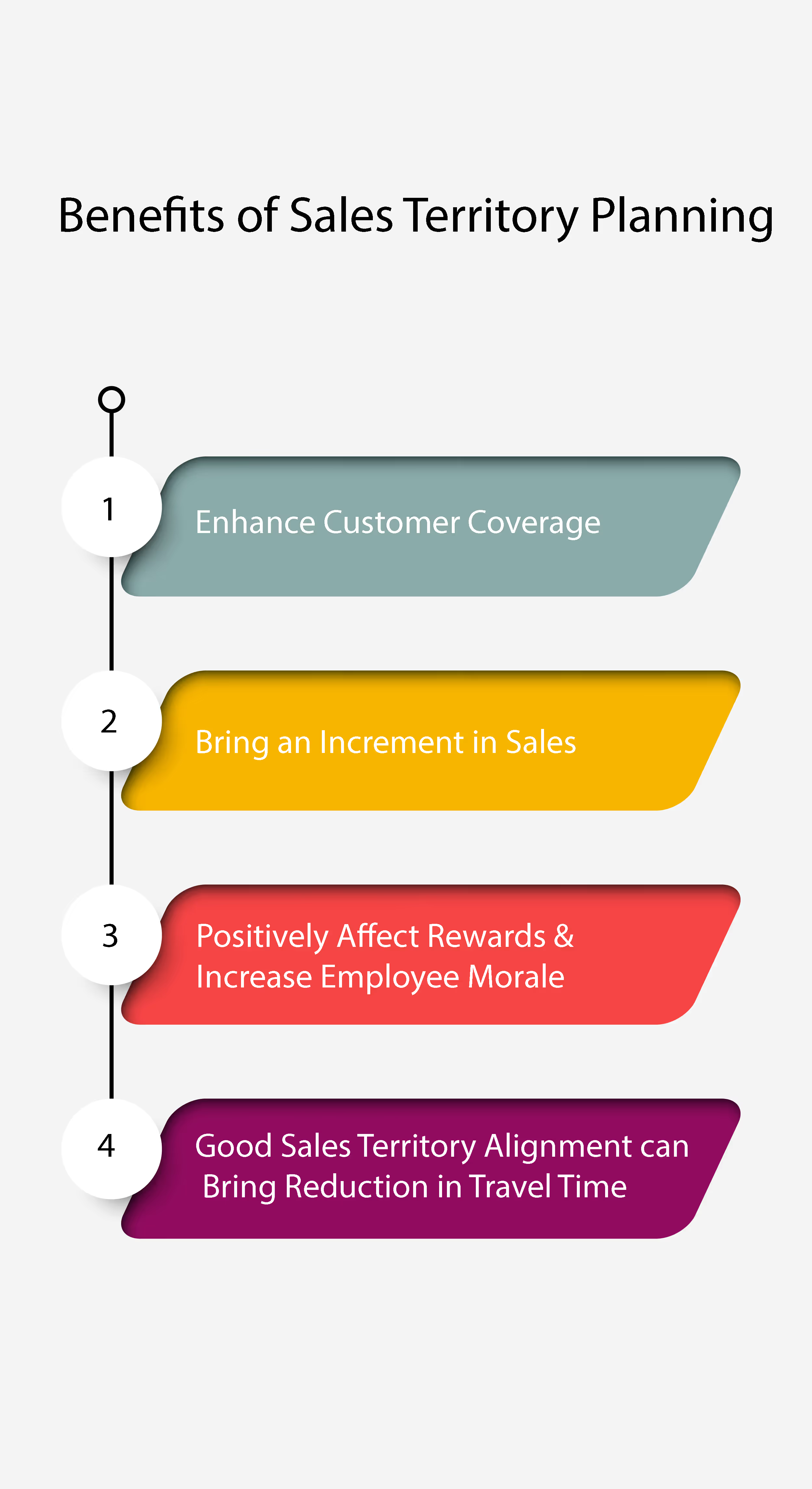
Blog
Guide To Create A Profitable Sales Territory Plan
July 25, 2022


Key Insights
A comprehensive and organized Sales Territory Plan is a critical part of any successful business. With the current challenges facing organizations, including digital worlds, complex offerings, and endless prospects, sales teams are at risk of lurching all over the place if they do not have a concrete sales territory plan. This could negatively affect the productivity of the organization. According to a study done by Harvard Business Review, territory design can increase revenue for an organization by 2% to 7% without the businesses making any changes to overall company strategy and resources. This change can also impact the performance significantly while yielding several positive benefits for the business, including:
- 15% higher revenue
- 15% increase in territory efficiency
- 20% increase in sales productivity
- 75% reduced planning time
- Up to 30% attainment in higher sales objective
Another study undertaken by Simon-Kurcher & Partners shows that with an investment in a digital approach to territory design, companies can see their revenues increase by up to 15 percent.
What is A Sales Territory?
A sales territory corresponds to a regional area, industry, or account type that a salesperson or sales team is assigned to. It is the responsibility of the territory owner to prospect into their existing customer base and reach their territory quota. Your sales team must identify which prospects to target and what goals need to be achieved to achieve growth and profitability. Historically, most organizations used to break down their territories by geography, but in today’s digital world, sales territories can also be divided in many ways including:
- Industry
- Sales potential
- Customer type
Benefits of Sales Territory Planning

You must ensure that your sales territories are aligned in a way that sets you up for success before you can begin managing them. An effective Territory alignment has more benefits now than ever before, including:
Enhance Customer Coverage
Potentially important customers are ignored when a sales territory is too large. There is simply not enough time for the salesmen to visit all customers. Creating a sales territory allows management to coordinate the team's activities to provide better customer service and equip salespeople with valuable sales resources examples. A well-designed sales territory allows sales personnel to spend sufficient time with customers and prospects while minimizing their travel time. Resultantly, they become extremely familiar with the problems and requirements of their customers. This also helps salespeople to reach out to different classes of customers and prospects.
Bring an Increment in Sales
The proper alignment of a sales territory is one of the most effective methods for gaining realistic sales planning and gaining better control over sales operations, thus leading to increased sales. It is advisable to utilize Territory-by-territory planning as a sales concept example for realistic sales planning. There is variance in the characteristics of customers and prospects in different sales territories and even from country to country. Market volume is more homogenous within a territory than in its entirety. Controlling sales operations is more effective when the total market is broken down into smaller units. When subordinate line executives and individual sales personnel are assigned responsibilities for achieving specific objectives, selling efforts are aligned with sales opportunities. It is advisable to adjust calls based on the potential of different accounts.
Positively Affect Rewards & Increase Employee Morale
Individual sales personnel and subordinate line executives are assigned responsibility for achieving specific objectives to align their efforts with sales opportunities. It helps sales managers analyze sales rep performance by using territory management software and analyzing how viable each territory is. A properly aligned sales territory eliminates any perception of favouritism among representatives and ensures fair dealings among representatives. By allowing every salesman to reach their quotas and make sales, they will have a higher sense of accomplishment within the organization, and they are more likely to stay longer, leading to less employee turnover.
Good Sales Territory Alignment can Bring Reduction in Travel Time
Each second your salespeople spend on the road means fewer sales for your company. In addition to higher fuel costs, longer travel times increase other expenses. You can decrease the travel time of your team by allocating customers and accounts to salespeople who are close by. As a result, they can handle more accounts and provide better service, resulting in higher customer satisfaction.

Other Benefits:
Additionally, there are the following benefits:
- Each territory improves the efficiency and effectiveness of the sales effort put in by salespeople.
- The ability to face domestic and international intensified competition is amplified.
- Enhances the energy levels of salespeople.
- Coordinating marketing functions is easier when the territory is defined.
- It encourages all salespersons to compete fairly.
- Provides the means for competitive institutions to compete with each other on a level playing field.
Factors To Consider When Planning Sales Territories
You will improve your sales results and efficiency if you align your sales territories correctly. However, when executed poorly, you risk wasting time on ineffective leads, providing poor customer service, or overloading your salespeople. As you align your sales territories, here are a few factors to consider:
- Customer Locations: Is your customer base distributed evenly?
- Account Size: Some accounts have more volume than others, which will require more work from your sales team.
- The Location of Your Salespeople: Does the location of your salespeople align with your ideal territories?
- Travel Distance: Your salespeople's travel time is important. How far will they have to travel so they can serve their customers?
- Opportunity: Will you be able to make sales and create new business in each territory?
Steps or tips to create a best sales territories plan
Analyze Your Business Goals And Objectives
Clarifying the organizational landscape, defining organizational goals, and analyzing industry trends is essential to drafting a great sales territory plan. It's important to understand what you're trying to accomplish with your sales territory plan in this first step. Getting started with the process requires answering the following questions: What is your organization’s most current vision, mission and aim? How is your industry or market evolving? How does your offering solve customers' pain spots? Do you have any products or services that you are selling more than others? Why? and how does your conversion rate compare?
Analyze Your Prospects And Customers
Taking a close look at your customer base is the next step. It is important to understand their distinct traits and characteristics and their business models, challenges, and what sets them apart from the rest. Some of the pertinent questions that you need to ask yourself before starting the analysis process are: Who are your most profitable and lucrative prospects and customers defined based on industry, region, product, etc.? How are these customers or prospects similar? What is your company's most promising prospect or customer? Which of these prospects offer growth to your company? Who and what are the biggest causes of objection from these customers and prospects, and why?
Determine Your Total Addressable Market
An organization's Total Addressable Market (TAM) contains all the potential prospects and customers who fit its ideal customer profile. To define their TAM, organizations typically use industry, location, size, and revenue data. Even though this is still a crucial element of your TAM analysis, the use of technology and tools can assist you in determining prospects you may have been unaware of. It is now advisable to search for competitors and industry look-alikes that may be a good match for your offering, using both traditional and modern sources. The next step in creating an ideal customer profile is determining the size of the market opportunity that fits the description, taking into account different sales cycle stages. A matrix can be used to include a range of large and small markets that offer both large and small opportunities. TAM discovery used to involve guesswork and complicated calculations, but now companies can automate the process by using modern and automated tools.
Perform A SWOT Analysis

A very simple way, which may never go out of fashion, to evaluate what your position in the market is, is to perform a SWOT (Strengths/Weaknesses/Opportunities/Threats) analysis.
- Strengths: Consider the things that your company is doing well, qualities that set you apart from your competitors, internal resources that you can use optimally such as knowledgeable staff, intellectual property and so on
- Weaknesses: Analyze what are the things that your company lacks, what gives your competitor an edge over you, what are your resource limitations, etc
- Opportunities: Analyze how you can take maximum opportunities out of having few competitors in your area, getting social media/press coverage of your company, the emerging need for your products/services and so on
- Threats: Consider who your emerging competitors are, whether the customer’s attitude is changing, whether you are getting negative social media/press coverage, etc
As a result of this analysis, you will start to see patterns that indicate where your organization needs more or less attention for a variety of reasons. It is unlikely that the SWOT characteristics you will analyze will always be connected to revenue or geography. Some of them may be more obscure issues like a need for training of your sales team, a gap in your tools and systems, or a flaw in your products.
Determine And Document Sales Territories
The sections above should help you determine how to divide up your sales territory based on what you have learned so far. Clearly documenting these territories, including details like these given below, is important:
- Geographic Boundaries
- Industry or Segment Boundaries (including any overlap, if any and how it is handled)
- Revenue Boundaries
- Product Boundaries
- Anything else your sales organization may need to know
Devise An Action Plan
The development of an action plan is a group effort that involves various stakeholders from within the company, particularly the leaders of each of the identified territories. As markets change every single day, sales territory plans should be set up to keep up with these changes, ensuring your business plan remains relevant to current and foreseen opportunities and threats.
Track Territory-Level Performance
As you devise and implement your sales territory plan, you should measure its success regularly and make adjustments if necessary. To avoid making this a manual, costly, and easily avoided overhead process, metric reviews should occur periodically in a defined and timely manner such as monthly or quarterly. They should also be automated using sales performance management tools that are now widely available. You should regularly evaluate some important measures are Gross Sales, Gross Profits, Total Unit Sales, Conversion Rates, Total Commissions, and Return Customers.
Conclusion
Territory design has become a key factor driving sales force productivity and performance, and companies no longer have any reason to undervalue it. It can be very beneficial for your business to use sales territory management to collect and organize the information you need. Any member of your team at any level of your organization will benefit from this. If incentivizing is an integral part of your sales strategy, you should have a look at Kennect’s tools designed to bring transparency and operational efficiency not just for today, but also prepare you better for tomorrow.
ReKennect : Stay ahead of the curve!
Subscribe to our bi-weekly newsletter packed with latest trends and insights on incentives.
Thank you! Your submission has been received!
Oops! Something went wrong while submitting the form.
Your data is in safe hands. Check out our Privacy policy for more info






.jpg)







